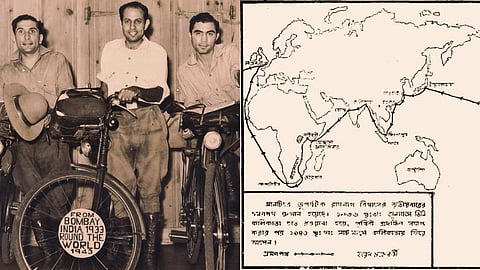
- HOMEGROWN WORLD
- #HGCREATORS
- #HGEXPLORE
- #HGVOICES
- #HGSHOP
- CAREERS
- ABOUT US
- CONTACT US

Their story, as chronicled in The Bicycle Diaries and With Cyclists Around the World, begins not with a grand manifesto, but with a simple yet audacious desire: to show the world that Indians were capable of greatness. Adi Hakim, Jal Bapasola, and Rustom Bhumgara were the first Indian trio to set out on this journey. For them, cycling was a means to rebel against the colonial narrative that painted Indians as subjugated and incapable.
In October 1923, six young men set off from Bombay on Royal Benson bicycles, each carrying Rs. 2,000, a compass, and a map. Their mission was straightforward: to cycle around the world. Over the next four and a half years, the 'Super Six', as they came to be known, pedaled through deserts, mountains, forests, and war-torn countries. They navigated the Syrian-Mesopotamian desert, survived the Alps, and crossed into lands where few Indians had ventured before.
Their trip was not without dangers. In the Iranian desert, they found themselves on the brink of death, saved only by the compassion of Bedouins. In Rome, they were arrested for alleged espionage, with their Indian passports and ragged appearance arousing suspicions. Yet, they continued. As they cycled through Europe, America, and Asia, they became accidental ambassadors, sharing stories of India’s rich cultural heritage and debunking myths about their homeland.
The accounts from their journey, meticulously documented by Adi Hakim, offer a unique perspective on a rapidly changing world. In China, they observed the stirrings of revolution, writing prophetically, “A new China has been born... Few see her; but those who do realize how she will affect world history.” In America, they marveled at the infrastructure — paved roads and roaring automobiles — but recoiled at the stark racial discrimination, which they described as “the most demeaning character.”
Their interactions with world leaders, including Pope Pius XI and Benito Mussolini, and their encounters with ordinary citizens in distant lands, revealed a world grappling with inequality, war, and modernisation. At every turn, they faced challenges — not just physical and financial, but existential. What did it mean to be Indian in a colonized world? How could they convey the complexity of their homeland to those who only saw it through the lens of British propaganda?
By the time Hakim, Bapasola, and Bhumgara returned to Bombay in March 1928, they had traveled over 40,000 miles across 27 countries. Their achievements inspired other Parsi cyclists to undertake similar global journeys. Framroze Davar, a sports journalist, cycled with Austrian Gustav Sztavjanik through uncharted territories like the Amazon and the Andes, documenting his anthropological observations in a series of books. Another trio, Kaikee Kharas, Rustam Ghandhi, and Rutton Shroff, ventured into Afghanistan and beyond during the volatile 1930s, witnessing Hitler’s Nuremberg rallies and cycling across Australia and New Zealand.
These expeditions were more than just feats of endurance. They were acts of cultural diplomacy, presenting a narrative of India that was dynamic, resilient, and modern. As Anoop Babani and Savia Viegas note in The Bicycle Diaries, the cyclists were storytellers, chronicling the intersections of history, geography, and human spirit.
What makes these stories so compelling nearly a century later is their resonance with contemporary questions about identity, ambition, and global interconnectedness. These cyclists lived in a world divided by colonialism, yet they traversed it as citizens of a shared planet. As India’s cycling culture undergoes a resurgence, with endurance events and premium bikes becoming more accessible, the legacy of these early pioneers is incredibly inspiring. It shows us that, tven in the face of adversity, you can ‘pedal’ toward greatness — not just for yourself but for an entire nation.
If you enjoyed reading this, here's more from Homegrown:
Melodies Across The Cosmos: How A Classical Indian Track Made It To Outer Space
The 15 Types Of Dinosaurs That Used To Roam India
Could India's Ancient Relationship With Psychedelics Pave The Way For Modern Wellness?
